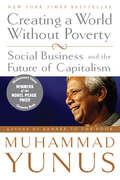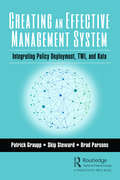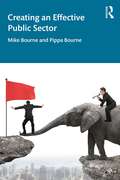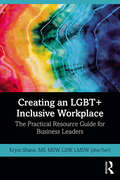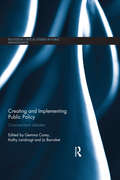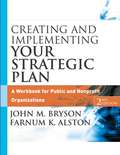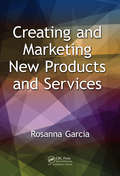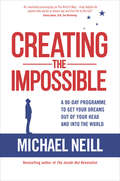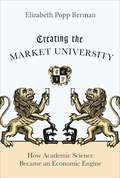- Table View
- List View
Creating a World Without Poverty: Social Business and the Future of Capitalism
by Muhammad YunusIn this newly updated national bestseller, Nobel Peace Prize?winner Muhammad Yunus outlines his vision of a new business model that combines the power of free markets with the quest for a more humane world.
Creating an EVEN Greater Whole: Becoming an Emotionally Intelligent Leader
by Susan G. SchwartzLeadership is not a solo sport; it’s about people and how they engage with one another. True leadership isn’t driven by an individual’s ego, but by the ability to connect, understand, and inspire others. Emotional Intelligence (EQ) enables leaders to shift their mindset, empowering their teams to reach their highest potential. Creating an Even Greater Whole: Becoming an Emotionally Intelligent Leader offers managers a fresh perspective and practical tools to navigate their leadership journey.
Creating an Effective Management System: Integrating Policy Deployment, TWI, and Kata
by Patrick Graupp Skip Steward Brad Parsons"The decades of experience-based wisdom that Graupp, Steward and Parsons share will set you on a new path to a more joyful organization and the tangible results it will produce." Rich Sheridan, CEO, Menlo Innovations; author of Joy, Inc. and Chief Joy Officer "A fine book by skilled practitioners that integrates Kata and TWI, with Strategy Deployment in pursuit of an integrated management system. Well done, Skip, Brad and Patrick." Pascal Dennis, president, Lean Pathways Inc.; author of Lean Production Simplified, Andy & Me, Andy & Me and the Hospital, Getting the Right Things Done, and The Remedy "In this practical and engaging book, Patrick Graupp, Skip Steward, and Brad Parsons give a concise and extremely clear explanation of what systems thinking looks like in a healthcare setting. And they do so in a way that translates easily to any type of organization. Highly recommended!" Alan Robinson, co-author of Ideas Are Free and The Idea-Driven Organization Despite the vast library of knowledge on Lean tools and models, the majority of Lean implementations fail to sustain themselves over time for lack of a functioning management system. In turn, when organizations try to apply a prescribed, one-size-fits-all, management system they inevitably find that what works for others may not work quite as well in their unique situation. Putting the right pieces in the right places is the prime challenge for every organization and no two successful management systems will, or should, be the same. This book provides and examines core principles that must be in place for an organization to find what an effective management system should constitute for them. It outlines key elements and how they work together as a necessary system to achieve overall success. Based on their extensive experience with organizational development and hands-on leadership in policy deployment, TWI and Kata, the authors describe their own journey in helping organizations discover and develop systems that function like well-designed and smooth-running machines while capturing the humanistic aspects of the foundational skills that emphasize the inherent synergy of the system. Readers will learn to help their own organizations "connect the dots" between the various pieces of Lean methodology and effectively create their own management systems that ultimately fulfil customers’ needs and expectations.
Creating an Effective Public Sector
by Pippa Bourne Mike BourneThis book offers an in-depth look at developing effectiveness in the public sector and how to achieve the best possible outcomes for people rather than just good or efficient outputs. In 15 comprehensive chapters, the authors present structured ideas and practical approaches for achieving a more effective public sector. The book sets out a framework for visualising success in complex situations with multiple stakeholders. Topics include how you stimulate change and influence people to adopt changes, how you manage politics, set targets and standards, and measure them, and how you create a culture of high performance with a focus on getting the right things done. Effectiveness does not arise from excellence in one area alone and the book weaves together ideas on leadership, managing expectations, and keeping focus on the longer term. Creating an Effective Public Sector will be of interest to decision makers in the public sector, project managers working on central and local government projects, and senior civil servants. It will also be invaluable for advanced undergraduate and post-graduate students studying in the fields of government, project management, and public-sector management.
Creating an Environment for Successful Projects, 3rd Edition: The Quest To Manage Project Management (Business And Management Ser.)
by Robert J. Graham Randall EnglundNow in its third edition, this project management classic has been updated with an array of field-tested tools to help upper management ensure the success of projects within organizations. For over twenty years, Creating an Environment for Successful Projects has been a staple for upper managers who want to help projects succeed. This new edition includes case studies from companies that have successfully applied the approach, along with practical tools such as templates, surveys, and benchmark reports for savvy leaders who want to ensure project success throughout their organizations. The insights in this book will help management speed projects along instead of getting in their way. All too often, well-intentioned managers put roadblocks in the team's way instead of empowering them with the tools they need to succeed. This approach to project environments, grounded in decades of research and practice, will help you make your organization the most project-friendly it's ever been. Organizational changes rarely work unless upper management is heavily involved. Although project managers are most closely responsible for the success of projects, upper managers are the ones who ultimately create an environment that supports those projects. The way upper managers define, structure, and act toward projects has an important effect on the success or failure of those projects and, consequently, the success or failure of the organization. This book helps all managers understand the need for project management changes and shows how to develop project management as an organizational practice.
Creating an HR Scorecard
by Dave Ulrich Brian E. Becker Mark A. HuselidA comprehensive HR Scorecard, though unique to each company, should cover four major themes: key human resource deliverables that will highlight HR's role in your firm's overall strategy, a High-Performance Work System, the alignment of that system with firm strategy, and the efficiency with which deliverables are generated. Guiding HR professionals through these steps, this chapter covers the essentials for constructing an HR Scorecard that will establish a balance between cost control and value creation.
Creating an Herbal Bodycare Business (Making A Living Naturally Ser.)
by Sandy MaineStart a profitable company making the natural products you love. Professional soapmaker Sandy Maine shares her business-building methods and inspiring philosophy to help you turn your passion into a vocation. Taking the mystery out of entrepreneurship, Maine provides clear advice on how to develop a sound business plan, identify your client base, create attractive packaging, set prices, manage an accounting system, employ staff, and much more. Get ready to take your herbal product to the marketplace.
Creating an LGBT+ Inclusive Workplace: The Practical Resource Guide for Business Leaders
by Kryss ShaneSetting out best practices and professional guidance for creating LGBT+ inclusive workplaces, this approachable and easy to follow book guides current and future leaders of all industries toward appropriate and proven ways to create safer working environments, update company policies, enhance continuing education and training, and better support LGBT+ people in the workplace. Featuring real-life situations and scenarios, a glossary, and further resources, Creating an LGBT+ Inclusive Workplace enables professionals in all aspects of professional roles to integrate foundational concepts into their everyday interactions with staff at all levels as well as within the community to create an overall workplace culture that nurtures a welcoming, inclusive, and affirming environment for all. This book includes postcards from PostSecret as its foreword and more than a dozen exclusive interviews from the world’s top leaders in a variety of industries with world-renowned reputations. Enabling professionals in a variety of business roles to create an overall workplace culture that nurtures a welcoming, inclusive, and affirming environment for all, this book is an essential resource for independent readers, department teams, and entire corporations.
Creating and Implementing Public Policy: Cross-sectoral debates (Routledge Critical Studies in Public Management)
by Gemma Carey Kathy Landvogt Jo BarraketIn order to address major social policy problems, governments need to break down sectoral barriers and create better working relationships between practitioners, policymakers and researchers. Currently, major blockages exist, and stereotypes abound. Academics are seen as out-of-touch and unresponsive, policymakers are perceived to be justifying policy decisions, and the community sector seeks more funding without demonstrating efficacy. These stereotypes are born out of a lack of understanding of the work and practices that exist across these three sectors. Drawing on ground-breaking research and partnerships, with contributions from senior public servants, this book explores the competing demands of different actors involved in policy change. It challenges current debates, assumptions and reflects a unique diversity of experiences. Combined with differing theoretical perspectives, it provides a uniquely practical insight for those seeking to influence public policy. This innovative text provides essential reading for community sector practitioners, academics and advanced level students in public policy, social policy and public administration, as well as for public service professionals.
Creating and Implementing Your Strategic Plan
by John M. Bryson Farnum K. AlstonCreating and Implementing Your Strategic Plan is the best-selling companion to John Bryson's landmark book, Strategic Planning for Public and Nonprofit Organizations. This new edition of the workbook is completely revised and updated and can be used as a stand-alone resource or as a companion to Strategic Planning for Public and Nonprofit Organizations. A step-by-step guide to putting strategic planning to work in public and nonprofit organizations, this indispensable workbook includes easy-to-understand worksheets and clear instructions for creating a strategic plan tailored to the needs of the individual organization. From setting up the meeting room to establishing a vision of the future, every step of the strategic planning process is covered. The workbook shows how to:Refine your organization's mission and valuesAssess your internal and external environmentIdentify and frame strategic issuesFormulate strategies to help manage the issuesCreate, review, and adopt the strategic planAssess the strategic planning process
Creating and Managing a CRM Platform for your Organisation
by Richard BoultonMore than ever, organisations are facing a data avalanche from various sources, be they in electronic or hard copy format. How an organisation manages this ever-increasingly important resource – data – can benefit or hinder its ability to achieve its objectives. Creating and Managing a CRM Platform for Your Organisation not only covers how the principles of data management, including data quality and data security, can be applied to an organisation’s customer relationship management (CRM) platform, but also highlights how aspects of data management, marketing and technology are needed to operate, develop and manage a CRM platform in order to carry out tasks such as reporting and analysis, developing data plans, undertaking data audits, data migrations and campaign mailings which will result in an organisation using data effectively in order to achieve its goals and objectives. The issues and topics covered apply to all organisations that use a CRM platform and the data it contains as part of their business activities, regardless of the industry sector or size of the organisation. A comprehensive overview of the practices that can be effectively implemented when managing a CRM platform, this book is essential reading for professionals involved in the administration of the CRM platform within their organisation and data management.
Creating and Marketing New Products and Services
by Rosanna GarciaThis textbook teaches the key business and marketing principles needed to successfully design and launch new products and services in an international marketplace. The book emphasizes marketing research techniques that can help firms identify the voice of the customer and incorporate these findings into their new product development process. It addresses the role of social networks in innovation, open innovation strategies, and international co-development efforts of new products and services.
Creating and Re-Creating Corporate Entrepreneurial Culture
by Alzira SalamaEntrepreneurship is often considered only in the context of new venture creation, small business issues, and the profiles and personalities of individual entrepreneurs. The emphasis in Creating and Re-Creating Corporate Entrepreneurial Culture is very much on the 'corporate', it focuses on the creation and maintenance of an entrepreneurial management culture that accelerates growth and enhances effectiveness and competitiveness in large organizations. Alzira Salama explains what constitutes entrepreneurial behaviour, how it is facilitated by organizational culture and why entrepreneurial corporate culture is fundamental to business success. She takes you through ways of identifying prevailing cultures and explains how cultures are reinforced or changed. Drawing on exemplary case studies from around the world, she tells the stories both of successful and unsuccessful interventions made in response to the need to move on from bureaucratic or authoritarian cultures. These include specific instances where the context has been privatization, merger and acquisition, transition in the wider economy, or a combination of any of these circumstances. This enlightening book will help managers and consultants, business educators, higher level students and those on executive programmes to understand the nature of an organization's culture, why it is as it is, whether it needs to change, and how it might be changed. Alzira Salama offers real world examples of how to create or re-create an entrepreneurial culture together with tools that will enable corporations to achieve it.
Creating and Sustaining Competitive Advantage
by Chandra S. MishraThis book develops a unified framework to explain the phenomena of competitive advantage and firm value creation in dynamic environments. Through a new strategic value creation theory, it explores how a firm can measure and sustain its competitive advantage through management incentives, capital market forces, organizational culture and structure, and social complexity. It also considers how management can utilize their resources and capabilities, shadow options, product market forces, customer needs, and organizational learning as a means to differentiate them from the competition. With an innovative approach to theory and research, it will be positioned to inform both scholars and practitioners in management, business strategy, and entrepreneurship on the process of competitive and sustainable value creation.
Creating the Corporate Soul: The Rise of Public Relations and Corporate Imagery in American Big Business
by Roland MarchandMarchand discusses how some companies came to recognize a need to enhance their social and moral legitimacy, and how they dealt with that realization during the twentieth century.
Creating the Demand Landscape: How Frito-Lay Positioned an Existing Brand to Intersect with Consumers' Daily Life--A New Approach to Measuring Consumer Behavior
by Erich JoachimsthalerRather than segmenting customers according to age, lifestyle, and regional and social characteristics, creating a demand landscape maps the intersection of behavior (activities, projects, tasks, and to-dos driven by goals, needs, urges, sensations, and desires in the social-cultural context) with the capacity of an innovation to fit in and embed itself in the way in which people operate every day. This chapter provides a step-by-step guide to creating a demand landscape for your company.
Creating the Discipline of Knowledge Management: The Latest In University Research
by Michael StankoskyIn this book Dr. Michael Stankosky, founder of the first doctoral program in knowledge management, sets out to provide a rationale and solid research basis for establishing Knowledge Management (KM) as an academic discipline. While it is widely known that Knowledge is the driver of our knowledge economy, Knowledge Management does not yet have the legitimacy that only rigorous academic research can provide. This book lays out the argument for KM as a separate academic discipline, with its own body of knowledge (theoretical constructs), guiding principles, and professional society. In creating an academic discipline, there has to be a widely accepted theoretical construct, arrived at by undergoing scholarly scientific investigation and accompanying rigor. This construct becomes the basis for an academic curriculum, and proven methodologies for practice. Thus, the chapters in this book bridge theory and practice, providing guiding principles to those embarking on or evaluating the merits of a KM program. As a methodology itself for undertaking the development of a body of knowledge, a KM Research Map was developed to guide scholars, researchers, and practitioners. This book presents this map, and showcases cutting-edge scholarship already performed in this nascent field by including the dissertation results of eleven KM scholar/practitioners.
Creating the French Behavioral Insights Team
by Emilie Billaud Michael Luca Ariella KristalThis case explores how neuroscientist Mariam Chammat helped set up the first behavioral insights team at the center of the French government, and encouraged French administrations to innovate and create policy initiatives based on psychological theories of influence and persuasion. Students are asked to assess 35 projects ripe for behavioral intervention and pick the winning proposals.
Creating the Guiding Coalition: Overcoming Barriers to Organizational Change
by John P. KotterBecause major change is so difficult to accomplish, a powerful force is required to sustain the process. A strong guiding coalition is always needed-one with the right composition, level of trust, and shared objective. This chapter was originally published as Chapter 4 of "Leading Change."
Creating the Impossible: How to Get Any Project Out of Your Head and into the World in Less Than 90 Days
by Michael NeillAre you ready to make your dreams come true?Michael Neill is widely recognized as one of the world’s leading life coaches, and his teachings have impacted everyone from housewives to CEOs and from gang members in prison to leaders at the United Nations. For the last decade, he has been sharing the principles that will allow you to create far more than you ever thought possible with far less struggle than you expected.Thousands of people from all over the world have already used the principles behind this 90-day program to reconnect with their creative spark and get their most important ideas and projects out of their head and into the world. Now it’s your turn…What if you could accomplish more than you ever imagined without the constant stress and pressure associated with "high achievement?"What if creating what you want to see in the world isn’t dependent on believing in yourself, or even believing that it’s possible?Whether you want breakthrough results for your business, yourself, or your life, this book will change the way you see yourself as you learn to make the impossible possible!
Creating the Market University: How Academic Science Became an Economic Engine
by Elizabeth Popp BermanWhen science adopts the logic of the marketAmerican universities today serve as economic engines, performing the scientific research that will create new industries, drive economic growth, and keep the United States globally competitive. But only a few decades ago, these same universities self-consciously held themselves apart from the world of commerce. Creating the Market University is the first book to systematically examine why academic science made such a dramatic move toward the market. Drawing on extensive historical research, Elizabeth Popp Berman shows how the government—influenced by the argument that innovation drives the economy—brought about this transformation.Americans have a long tradition of making heroes out of their inventors. But before the 1960s and '70s neither policymakers nor economists paid much attention to the critical economic role played by innovation. However, during the late 1970s, a confluence of events—industry concern with the perceived deterioration of innovation in the United States, a growing body of economic research on innovation's importance, and the stagnation of the larger economy—led to a broad political interest in fostering invention. The policy decisions shaped by this change were diverse, influencing arenas from patents and taxes to pensions and science policy, and encouraged practices that would focus specifically on the economic value of academic science. By the early 1980s, universities were nurturing the rapid growth of areas such as biotech entrepreneurship, patenting, and university-industry research centers.Contributing to debates about the relationship between universities, government, and industry, Creating the Market University sheds light on how knowledge and politics intersect to structure the economy.
Creating the Modular Organization, by Michael Shank
by Stephan H. HaeckelSense-and-respond organizations are modular organizations, and in modular organizations, strategy becomes structure as businesses seek to seize competitive advantage through modularity, using it to customize large numbers of profitable responses to individual customers. In this chapter, Michael Shank defines and describes the modular organization and outlines the choices executives must make when transforming their firms for successful modularity.
Creating the Nazi Marketplace
by S. Jonathan WiesenWhen the Nazis came to power in 1933, they promised to build a vibrant consumer society. But they faced a dilemma. They recognized that consolidating support for the regime required providing Germans with the products they desired. At the same time, the Nazis worried about the degrading cultural effects of mass consumption and its association with "Jewish" interests. This book examines how both the state and private companies sought to overcome this predicament. Drawing on a wide range of sources - advertisements, exhibition programs, films, consumer research, and marketing publications - the book traces the ways National Socialists attempted to create their own distinctive world of buying and selling. At the same time, it shows how corporate leaders and everyday Germans navigated what S. Jonathan Wiesen calls "the Nazi marketplace. " A groundbreaking work that combines cultural, intellectual, and business history, Creating the Nazi Marketplace offers an innovative interpretation of commerce and ideology in the Third Reich.
